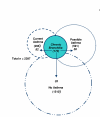Chronic productive cough in school children: prevalence and associations with asthma and environmental tobacco smoke exposure
- PMID: 17192188
- PMCID: PMC1770929
- DOI: 10.1186/1745-9974-2-11
Chronic productive cough in school children: prevalence and associations with asthma and environmental tobacco smoke exposure
Abstract
Background: The relationships between chronic productive cough (CPC), environmental tobacco smoke (ETS) exposure, and asthma are not clearly established in children. Therefore, we wished to determine the prevalence of CPC and examine the relationships between CPC, ETS exposure, and asthma in young teenagers.
Methods: We performed a cross sectional survey of 2397 Seattle middle school students, 11-15 years old, using written and video respiratory-symptom questionnaires. We defined CPC as--daily cough productive of phlegm for at least 3 months out of the year; current asthma as--yes to "Have you had wheezing or whistling in your chest in the past 12 months?" and yes in the past year to any of the four video wheezing/asthma video scenarios; and ETS exposure as exposed to tobacco smoke at least several hours each day. We used multilogistic regression to examine relationships between CPC, asthma, and ETS exposure and included in the model the potentially confounding variables race, gender, and allergic rhinitis.
Results: The prevalence of CPC was 7.2%. Forty-seven percent (82/173) of children with CPC met criteria for current asthma, while only 10% (214/2224) of those without CPC had current asthma. Current asthma had the strongest associated with CPC, odds ratio (OR) 6.4 [95% CI 4.5-9.0], and ETS was independently associated with both CPC, OR 2.7 [1.8-4.1] and asthma, OR 2.7 [1.5-4.7].
Conclusion: In a population of young teenagers, CPC was strongly associated with report of current asthma symptoms and also with ETS exposure. This suggests that asthma and ETS exposure may contribute to CPC in children. However, this study was not designed to determine whether asthma was the actual cause of CPC in this population of children.
Figures

References
-
- Irwin RS, Corrao WM, Pratter MR. Chronic persistent cough in the adult: the spectrum and frequency of causes and successful outcome of specific therapy. Am Rev Respir Dis. 1981;123:413–417. - PubMed
-
- Irwin RS, Curley FJ, French CL. Chronic cough. The spectrum and frequency of causes, key components of the diagnostic evaluation, and outcome of specific therapy. Am Rev Respir Dis. 1990;141:640–647. - PubMed
-
- Peat JK, Woolcock AJ, Leeder SR, Blackburn CRB. Asthma and bronchitis in Sydney schoolchildren. 1. Prevalence during a six-year study. Am J Epidemio. 1980;111:721–727. - PubMed
-
- NHL National Heart Lung and Blood Institute Guidelines for the Diagnosis and management of Asthma: Expert Panel Report No. 2. NIH Publication No 97-4051. 1997.
-
- Cunningham J, O'Connor GT, Dockery DW, Speizer FE. Environmental tobacco smoke, wheezing, and asthma in children in 24 communities. Am J Respir Crit Care Med. 1996;153:218–224. - PubMed
LinkOut - more resources
Full Text Sources
Miscellaneous

